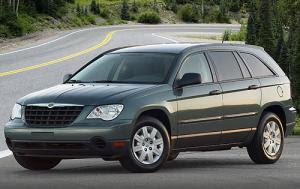Chrysler pacifica
The Chrysler Pacifica was one of the original large crossover wagons. In order to combine the driving attributes of a car with the utility offered by minivans and sport-utility vehicles, the Pacifica crossover had four front-hinged doors, an elevated seating position, five- or six-passenger seating and a choice of front-wheel drive or all-wheel drive.Compared to other crossover wagons, the Chrysler Pacifica was relatively upscale and offered a wide array of creature comforts wrapped in elegantly chiseled sheet metal. Unfortunately, the Pacifica didn't possess particularly great interior packaging. While the first two rows were spacious for occupants, the third row was acceptable only for children and left very little space for cargo behind it when deployed. The rearmost seat does, however, fold flat into the floor in convenient 50/50 sections.
The Pacifica's Mercedes Benz-derived suspension garnered wide praise for its carlike ride and handling. But early Pacificas suffered from reliability woes and mediocre engines in a price bracket where potent and refined powertrains were the norm. Not helping matters were the large wagon's hefty weight and relatively unsophisticated four-speed automatic transmission, both of which took their toll on fuel economy. A significant update for 2007, however, brought about a new V6 engine, a new six-speed automatic for most models and updated styling.
The Chrysler Pacifica debuted for the 2004 model year, at which point it was offered only in base and Limited trim levels. The original base model was relatively well-equipped, but it was offered with fewer features and a lower price when the Touring trim level slotted in above it in 2005. At first, Pacificas were powered by a 3.8-liter V6 with 210 horsepower and 240 pound-feet of torque. Reviewers faulted the gruff engine, which was barely up to the task of battling the Pacifica's formidable mass, especially on fully loaded all-wheel-drive models. Given that early 2004 Pacificas also had some well-known repair issues, we'd play it safe and restrict our search to 2005 and newer models.
A 3.5-liter V6 with 250 hp and 250 lb-ft became standard on all but the base front-wheel-drive model in 2005, and the 3.8-liter V6 was eliminated for 2006, leaving the 3.5-liter unit as the sole available engine. For 2007, the 3.8-liter mill returned in the base front-wheel-drive model, this time rated at 200 hp, and a 4.0-liter V6 replaced the 3.5-liter V6 in all other models. The 4.0-liter engine cranked out a respectable 255 hp and 265 lb-ft, and it was teamed with a new six-speed automatic transmission (the base engine continued with the old four-speed unit). All Pacificas were rated to tow up to 3,500 pounds.
Base 2004 Pacificas featured two-row, five-passenger seating and were fairly comfortable, thanks to niceties such as dual-zone climate control, a power driver seat and a load-leveling suspension. Starting in 2005, Touring models received additional standard features, a much longer options list and six-passenger seating via the addition of a two-passenger third-row seat and the replacement of the regular second-row bench with two bucket seats and a center console. The 2005 base model, meanwhile, lost some standard accoutrements and was priced lower going forward. The best-dressed and most luxurious Chrysler Pacifica was the Limited, which featured cleaner styling, bigger wheels and a long list of luxury features, including an upmarket audio system and a power liftgate.
In Chrysler Pacifica reviews, our editors found the crossover wagon's strengths to be its exceptional comfort for four, sedanlike driving characteristics, top-notch safety scores and upscale interior. The 3.8-liter engine is to be avoided, but the 3.5-liter and 4.0-liter V6s are decent performers. Downsides include a lack of legroom in the third row and a lack of overall utility when compared to the top available minivans.








0 comments:
Post a Comment